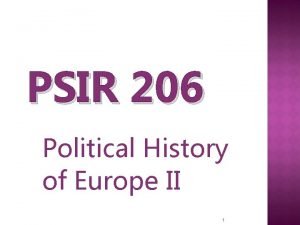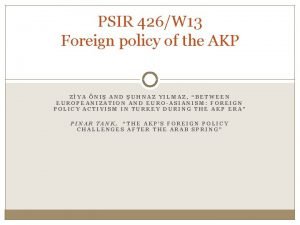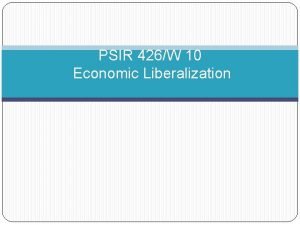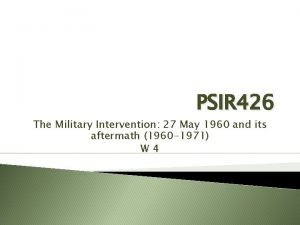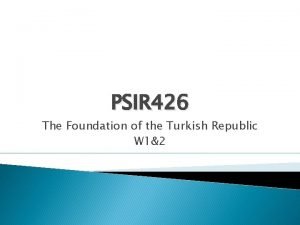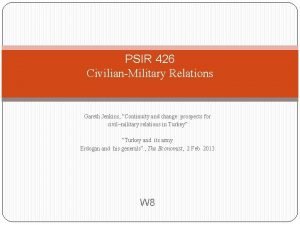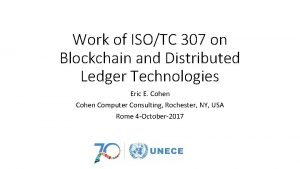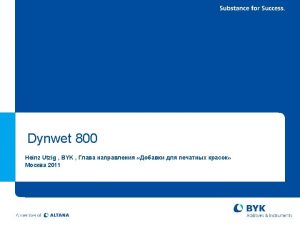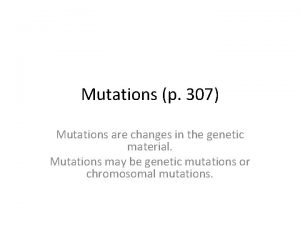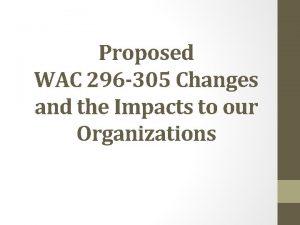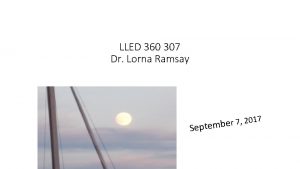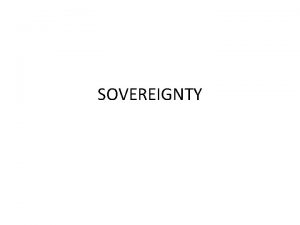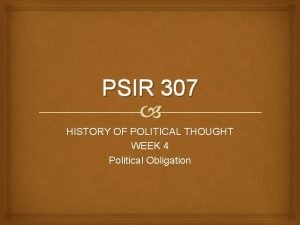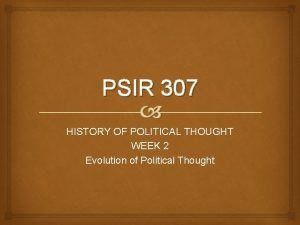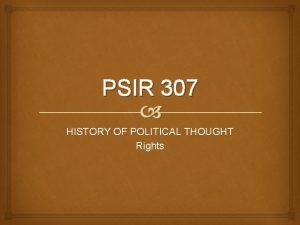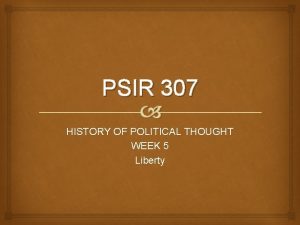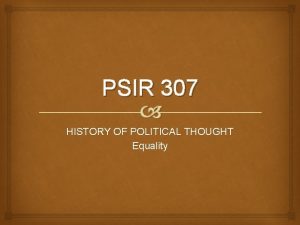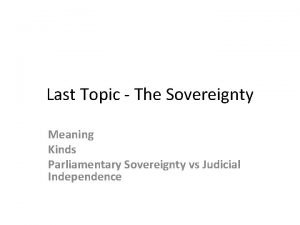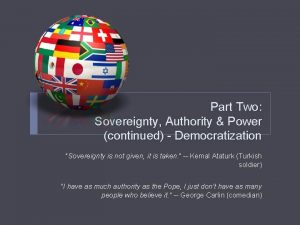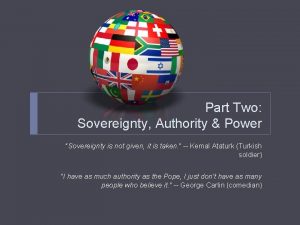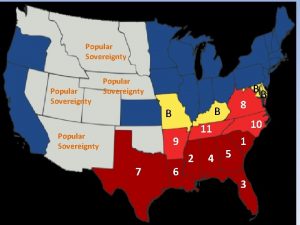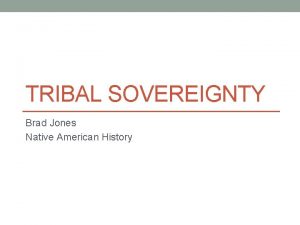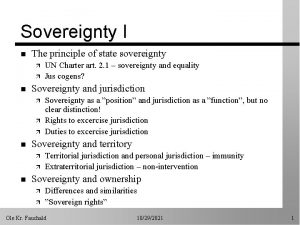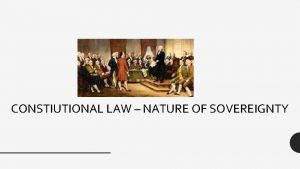Sovereignty PSIR 307 a summary from the Stanford






















- Slides: 22

Sovereignty PSIR 307

(a summary from the Stanford. Plato) • supreme authority within a territory • three dimensions – the holder of sovereignty – the absoluteness of sovereignty – internal and external dimensions of sovereignty.

• The state is the political institution in which sovereignty is embodied. An assemblage of states forms a sovereign states system.

two movements • the development of a system of sovereign states, culminating at the Peace of Westphalia in 1648 • the circumscription of the sovereign state, which began in practice after World War II and has since continued through European integration and the growth and strengthening of laws and practices to protect human rights

Definition • The King's Two Bodies (1957), medievalist Ernst Kantorowicz: – the body of Christ evolved into a notion of two bodies • corpus naturale, the consecrated host on the altar • the corpus mysticum, the social body of the church with its attendant administrative structure. • “This latter notion — of a collective social organization having an enduring, mystical essence — would come to be transferred to political entities, the body politic. ”

the king's two bodies • “Whereas the king's natural, mortal body would pass away with his death, he was also thought to have an enduring, supernatural one that could not be destroyed, even by assassination, for it represented the mystical dignity and justice of the body politic. ”

• The modern polity that emerged dominant in early modern Europe manifested the qualities of the collectivity that Kantorowicz described: – a single, unified one, confined within territorial borders, possessing a single set of interests, ruled by an authority that was bundled into a single entity and held supremacy in advancing the interests of the polity.

• “Though in early modern times, kings would hold this authority, later practitioners of it would include the people ruling through a constitution, nations, the Communist Party, dictators, juntas, and theocracies. The modern polity is known as the state, and the fundamental characteristic of authority within it, sovereignty. ”

Who possesses sovereignty? • supreme authority within a territory. – modern states possessed, but which popes, emperors, kings, bishops, and most nobles and vassals during the Middle Ages lacked.

Aspects of sovereignty • 1) a holder of sovereignty possesses authority. – Authority: “the right to command correlatively the right to be obeyed” (Wolff, 1990, 20) – source of legitimacy: natural law, a divine mandate, hereditary law, a constitution, even international law.

• 2) Supreme authority: The holder of sovereignty is superior to all authorities under its purview. Supremacy is endemic to modernity. During the Middle Ages, manifold authorities held some sort of legal warrant for their authority, whether feudal, canonical, or otherwise, but very rarely did such warrant confer supremacy.

• 3) Territoriality: Territoriality is a principle by which members of a community are to be defined. – International relations theorists have indeed pointed out the similarity between sovereignty and another institution in which lines demarcate land — private property. Indeed, the two prominently rose together in the thought of Thomas Hobbes.

the holders of sovereignty, • kings, dictators, peoples ruling through constitutions – French theorist Jean Bodin thought that sovereignty must reside in a single individual. Both he and English philosopher Thomas Hobbes conceived the sovereign as being above the law. Later thinkers differed, coming to envision new loci for sovereignty, but remaining committed to the principle.

Sovereignty can also be absolute or non-absolute • How is it possible that sovereignty might be nonabsolute if it is also supreme? – Absoluteness refers not to the extent or character of sovereignty, which must always be supreme, but rather to the scope of matters over which a holder of authority is sovereign. – Bodin and Hobbes envisioned sovereignty as absolute, extending to all matters within the territory, unconditionally. It is possible for an authority to be sovereign over some matters within a territory, but not all.

“internal” and “external” sovereignty • Sovereign authority is exercised within borders, but also, by definition, with respect to outsiders, who may not interfere with the sovereign's governance. • The concept of sovereignty in international law most often connotes external sovereignty. • external sovereignty depends on recognition by outsiders. To states, this recognition is what a notrespassing law is to private property — a set of mutual understandings that give property, or the state, immunity from outside interference.

2. The Rise of the Sovereign State: Theory and Practice • two broad movements – a centuries long evolution towards a European continent, then a globe, of sovereign states – circumscription of absolute sovereign prerogatives in the second half of the twentieth century

• the Peace of Augsburg, whose formula cuius regio, eius religio, allowed German princes to enforce their own faith within their territory. • Westphalia: The temporal powers of the Church were also curtailed to the point that they no longer challenged any state's sovereignty. In reaction, Pope Innocent X condemned the treaties of the peace as “null, void, invalid, iniquitous, unjust, damnable, reprobate, inane, empty of meaning and effect for all time” (quoted in Maland 1966, 16)

3. The Circumscription of the Sovereign State: Theory and Practice • It was in 1948 that the vast majority of states signed the Universal Declaration of Human Rights, committing themselves to respect over 30 separate rights for individuals. • In a series of several episodes beginning in 1990, the United Nations or another international organization has endorsed a political action, usually involving military force, that the broad consensus of states would have previously regarded as illegitimate interference in internal affairs. – Iraq, the former Yugoslavia, Bosnia, Kosovo, Somalia, Rwanda, Haiti, Cambodia, Liberia, Libya and elsewhere

• The Responsibility to Protect, a document written and produced in 2001 by the International Commission on Intervention and State Sovereignty, a commission that the Government of Canada convened at the behest of U. N. Secretary General Kofi Annan

• European integration: – Historically, the most enthusiastic supporters of European integration have indeed come from Catholic Christian Democratic parties, whose ideals are rooted in medieval Christendom, where at least in theory, no leader was sovereign and all leaders were accountable to a universal set of values.

• Hugo Grotius, Alberico Gentili, and Francisco Suarez, though they accepted the state as a legitimate institution, thought that its authority ought to be limited, not absolute.

Conclusion • The case for circumscribing sovereignty remains strong in the Catholic and other Christian traditions. Pope Benedict XVI made a case for the Responsibility to Protect, for instance, in his 2008 speech to the United Nations. • In recent years, political philosophers in the liberal tradition have argued for the circumscription of sovereignty as well. Two examples are Thomas Pogge (1992, and 2008, 174201) and Allen Buchanan (2004). Both accord sovereignty an important but not an absolute moral status, seeking to make room for possibilities such as humanitarian intervention approved by the United Nations and the more robust development of global institutions for fighting poverty.

